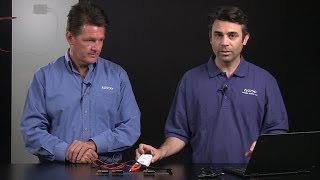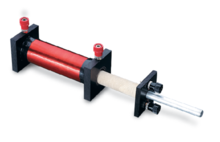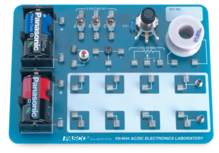



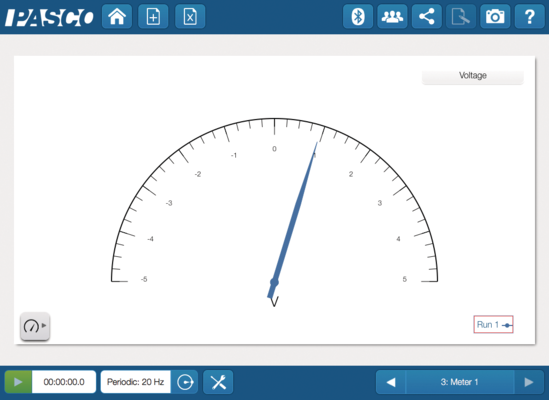




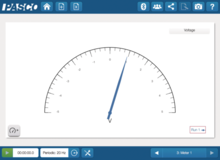
Easily record voltage data while exploring fundamental circuit concepts, electrochemical batteries, and so much more.
- 1x Wireless Voltage Sensor
- 1x USB Cable
- 1x Red, Banana-to-alligator-clip
- 1x Black, Banana-to-alligator-clip
See the Buying Guide for this item's required, recommended, and additional accessories.
Product Summary
The Wireless Voltage Sensor is ideal for exploring the fundamental concepts of electricity, voltage, and basic circuits. It measures voltages up to ±15 V with built-in overload protection, and features high-speed sampling rates when used with a USB connection. When combined with the Wireless Current Sensor, students can use it to explore Ohm's Law, circuits in series and parallel, and much more.
In Chemistry, the sensor helps students investigate redox reactions, electrolytic cells potentials, and impact of strength of solution on these generated potentials. By testing potential differences between two half reactions, separated by a salt bridge, students can begin to understand the driving forces behind modern batteries.
Features
- Two Ranges: ±15 V, ±5 V
- Resolution: 7 mV (±15 V range); 2 mV (±5 V range)
- Bluetooth® sampling rate of 1 kHz
- Higher speed sampling via USB
Applications
- Measure the electrical energy generated by an electrochemical battery
- Measure the energy generated by a wind turbine or other renewable energy source
- Measure the voltage across components in a simple circuit
- Measure the induced voltage in a wire coil as a magnet passes through
Perform These Experiments
- Kirchhoff's Voltage Law
- Ohm's Law
- RC and LRC circuit analysis
- Faraday's Law of Induction
What's Included
- 1x Wireless Voltage Sensor
- 1x USB Cable
- 1x Red, Banana-to-alligator-clip
- 1x Black, Banana-to-alligator-clip
Product Specifications
| Low Voltage |
|
| High Voltage |
|
| Accuracy | ±1.0% |
| Input Resistance | 1 MΩ |
| Maximum Sample Rate | 100 kHz |
| Connectivity | USB and Bluetooth 5.2 |
| Logging | Yes |
| Battery Type | Rechargeable LiPo |
Data Collection Software
This product requires PASCO software for data collection and analysis. We recommend the following option(s). For more information on which is right for your classroom, see our Software Comparison: SPARKvue vs. Capstone »
Connectivity Options
This product can connect directly to your computer or device with the following technologies. No Interface required. See the following guide for details regarding device compatibility: Wireless Bluetooth Product Compatibility »
- Bluetooth Low Energy (BLE)
- Universal Serial Bus (USB)
Dedicated Datalogging with SPARK LXi2
Consider an all-in-one, touchscreen data collection, graphing, and analysis tool for students. Designed for use with wired and wireless sensors, the SPARK LXi2 Datalogger simultaneously accommodates up to five wireless sensors and includes two ports for blue PASPORT sensors. It features an interactive, icon-based user interface within a shock-absorbing case and arrives packaged with SPARKvue, MatchGraph!, and Spectrometry software for interactive data collection and analysis. It can additionally connect via Bluetooth to the following interfaces: AirLink, SPARKlink Air, and 550 Universal Interface.
Buying Guide
| Recommended Accessories | P/N | Price |
|---|---|---|
| Wireless Sensor Charging Station | PS-3599 | -- |
| Storage Tray for Wireless Voltage & Current Sensor | PS-3588 | -- |
| Replacement Parts | P/N | Price |
|---|---|---|
| Shrouded Alligator Test Leads | PS-3544 | -- |
| Micro USB Cable | PS-3584 | -- |
| Also Available | P/N | Price |
|---|---|---|
| Wireless Voltage Sensor Pack | PS-3335 | -- |
Product Guides & Articles
Voltage and Current Sensors
Educational voltage and current sensors don’t have to look serious to have seriously powerful capabilities. We provide user-friendly voltage and current sensors that generate live data to improve students’ contextual understanding of electrical concepts. This page provides a comparison chart of our offerings to help you make an informed purchase.
Experiment Library
Perform the following experiments and more with the Wireless Voltage Sensor.
Visit PASCO's Experiment Library to view more activities.
DC Circuits
Students use a voltage sensor, a current sensor, and an AC/DC electronics laboratory to construct simple resistor circuits with resistors in series or in parallel, or both (with at most one parallel loop of resistors), to demonstrate...
Fruit Battery
Students will construct an electrochemical cell using common materials. They will explore how the voltage changes as the cells are connected in series.
Exploring Inductors
Students construct a circuit that produces current in an inductor and use a compass to investigate its properties. They remove the batteries and use a magnet to produce current in the circuit by moving it by the inductor. They...
Design a Lemon Battery
Design a battery using different metals inserted into a lemon. Test the effect of different metals. Use a voltage sensor to measure voltage.
Project: Design a Galvanic Cell
Students use a voltage sensor and a variety of supplies to design a galvanic cell that can light LED bulbs in series or in parallel.
Electrochemical Cells
Students use a voltage sensor to discover the function of the components of an electrochemical cell.
RC Circuits
Students use a voltage sensor and a current sensor with the AC/DC electronics laboratory to determine how the potential differences across the resistors and capacitor in a simple RC circuit differ when the capacitor is charging,...
Ohm's Law
Students measure the current and voltage across a resistor while varying the output voltage, A graph of voltage versus current will reveal Ohm's Law. This version uses the potentiometer module to vary the voltage.
Planck's Constant
Students use a voltage sensor and an AC/DC electronics laboratory to measure the turn-on voltage of various colors of LEDs and then plot the turn-on voltage versus LED frequency to determine the value of Planck’s constant.
Nernst Equation: Concentration versus Cell Potential
Students use a Wireless voltage sensor, Chemvue software, and Nernst equation calculations to compare measured Zn-Cu cell voltage against predicted values at standard and non-standard electrolyte concentrations.
Lemon Battery
Students use a voltage sensor to measure voltage produced by a lemon battery with copper and zinc electrodes, then use their data to design a lemon battery that produces enough voltage to light an LED.
DC Circuits
Students construct a circuit consisting of two resistors in series and then in parallel. They measure the voltage across the resistors, and the current through the resistors. From their measurements they can infer Kirchhoff's...
Support Documents
| Manuals | ||
|---|---|---|
| Wireless Voltage Sensor Manual | English - 1.33 MB | |
| Safety Sheets | ||
| Lithium Battery Safety Data Sheet | English - 593.56 KB | |
| Knowledge Base | ||
| How do I troubleshoot connecting a wireless sensor? | Aug 22nd, 2022 | |
| Windows asks for a PIN number when connecting wireless sensor or device | Sep 18th, 2023 | |
| Wireless sensor or device not charging | Mar 4th, 2024 | |
| Android asks for a PIN number to pair a wireless device to system | Aug 29th, 2023 | |
| Battery replacement instructions for PS-3211 | Apr 4th, 2024 | |
| Battery warranty for rechargeable lithium ion and lithium polymer batteries | Mar 13th, 2023 | |
| How to install the Data Streamer app extension within Microsoft Excel | Apr 5th, 2023 | |
| Tips for use of micro USB cables | Aug 29th, 2023 | |






